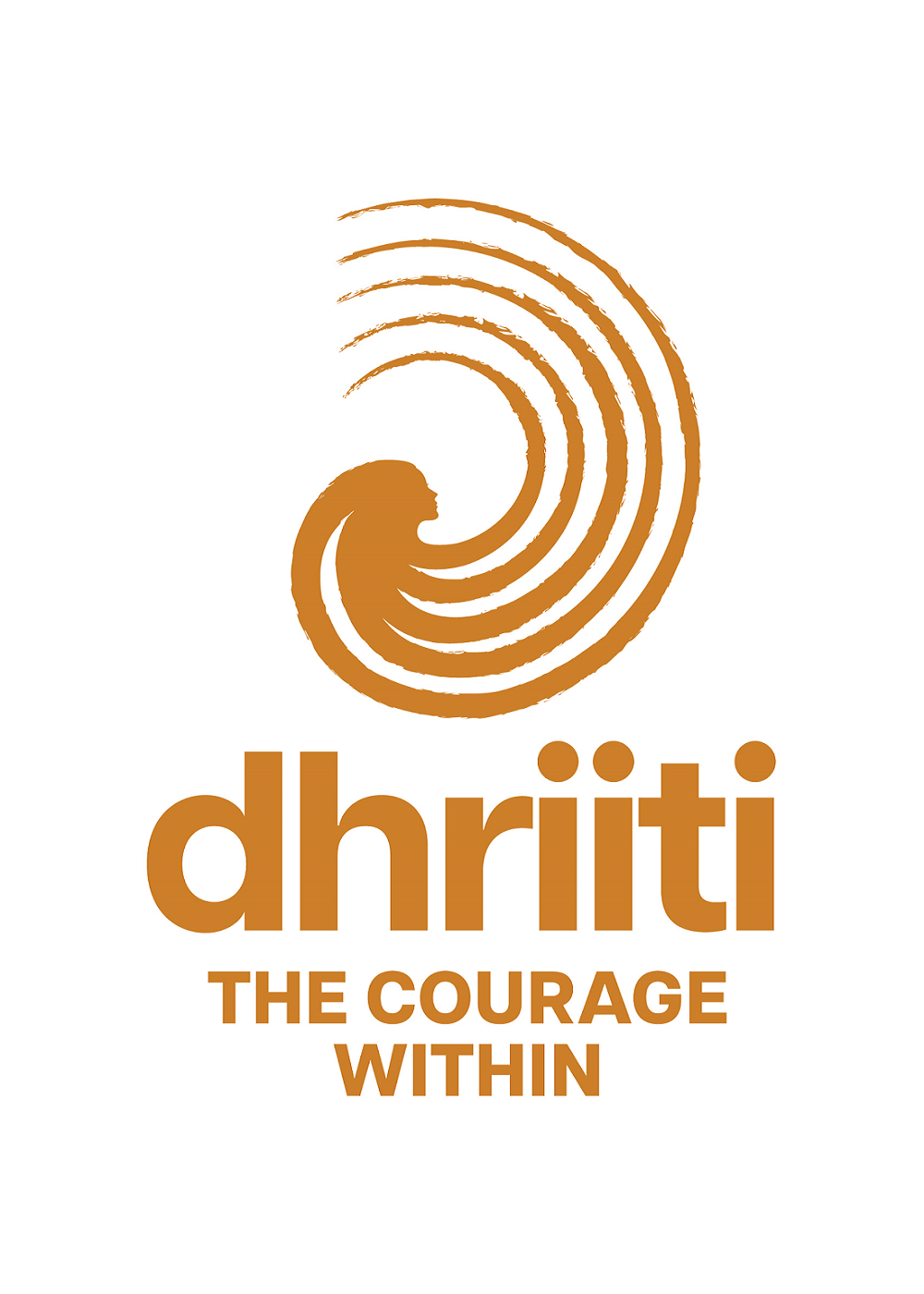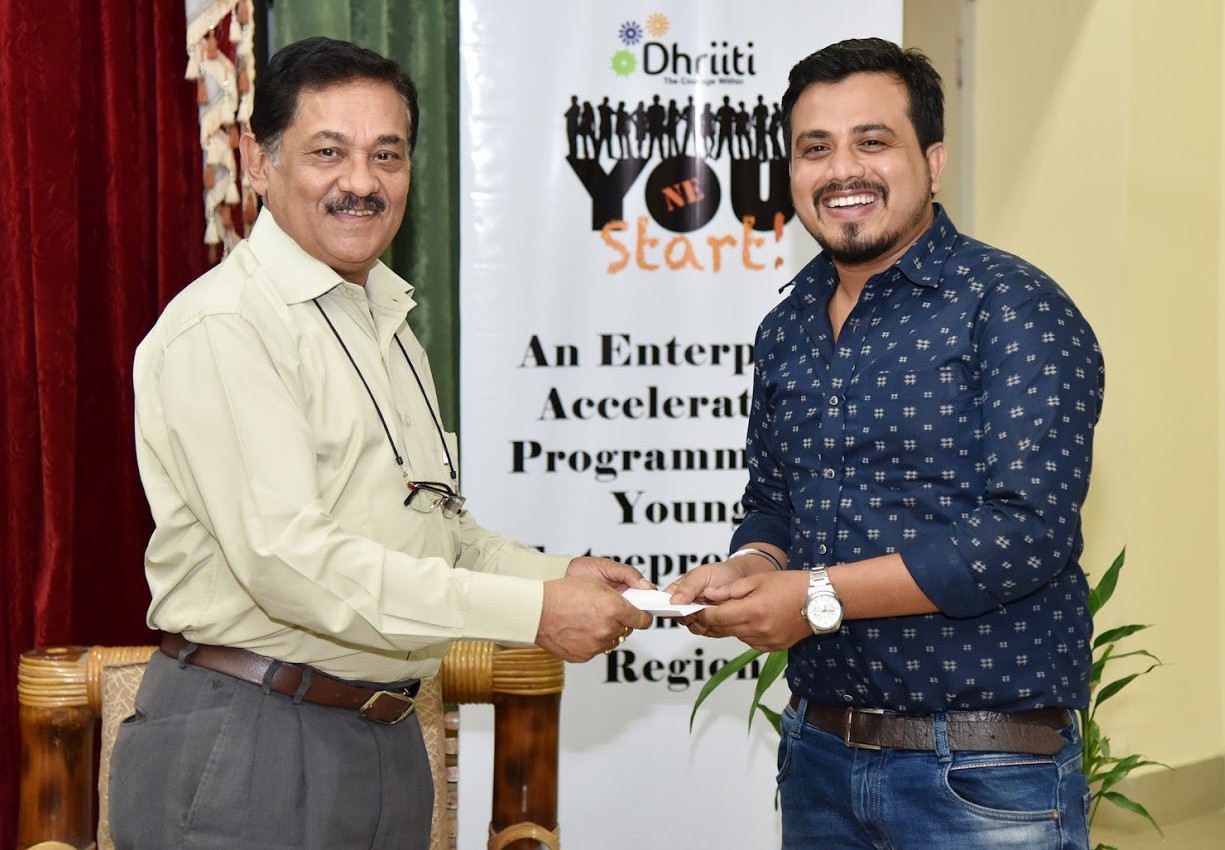
Dhriiti You Start! NE – Entrepreneur Awards 2018
YOU Start! NE – Enterprise Acceleration Programme for Youth Entrepreneurs – is an initiative dedicated to promoting youth entrepreneurship in North East India. After receiving approximately 100 application from states covering Assam, Meghalaya, Mizoram, Nagaland, Tripura and Manipur, we shortlisted and trained 52 young entrepreneurs from this region in 3 different cities i.e. Shillong, Guwahati and Dimapur. This was followed by mentoring support to each of the trained entrepreneur to enable them to develop robust enterprise plans, providing them with a solid foundation to sustain and grow their enterprises. 11 entrepreneurs were selected after the Ist round of Business Plan competition. This was followed by 12 weeks of mentoring support to accelerate their businesses. We are gearing up for the final event where 8 young entrepreneurs will be competing. The competition will be two segments one which is online voting and second is business pitches.
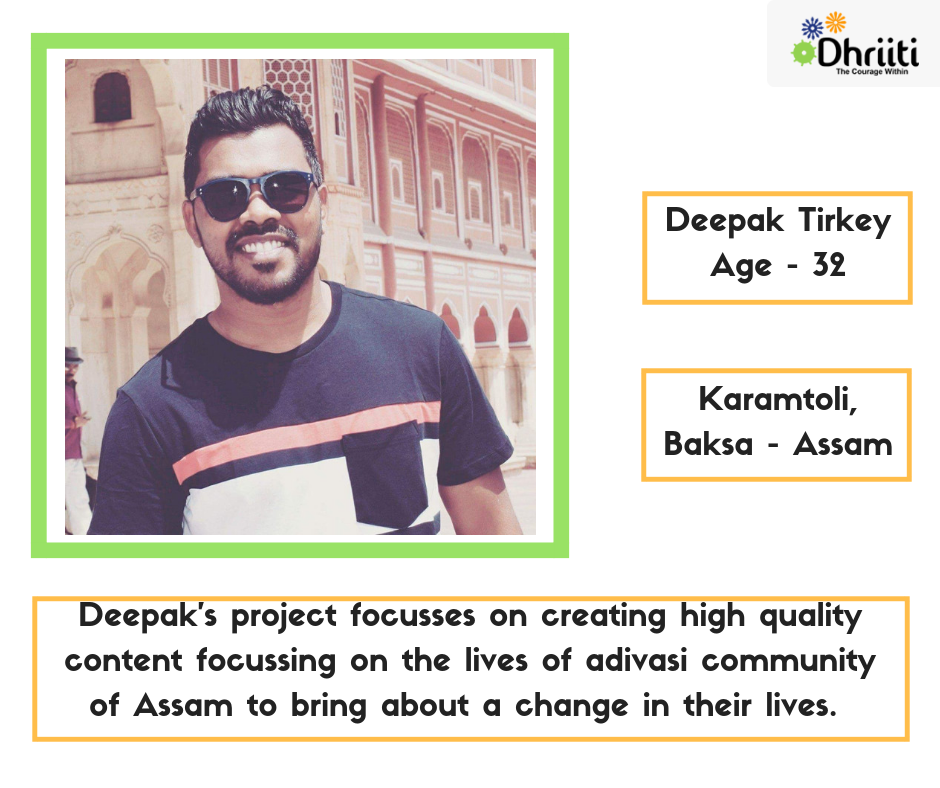 Deepak comes from the adivasi community of a small village of Baksa district of Assam. He completed his graduation from St. Anthony’s College, Shillong in Mass Communication and Video Production. He worked for 6 years in NDTV as an associate producer. But he longed to return back to his home and produced short films in Sadri language (native) portraying the stories of this region. In this process, he started his venture Westudios, an animation and video production company that aims to create quality content focusing on the Adivasi community of Assam. The basic idea is to create and produce audio-visual regional content in the realms of the performing arts, new media art, film, television, video, animation, design, etc.
Deepak comes from the adivasi community of a small village of Baksa district of Assam. He completed his graduation from St. Anthony’s College, Shillong in Mass Communication and Video Production. He worked for 6 years in NDTV as an associate producer. But he longed to return back to his home and produced short films in Sadri language (native) portraying the stories of this region. In this process, he started his venture Westudios, an animation and video production company that aims to create quality content focusing on the Adivasi community of Assam. The basic idea is to create and produce audio-visual regional content in the realms of the performing arts, new media art, film, television, video, animation, design, etc.
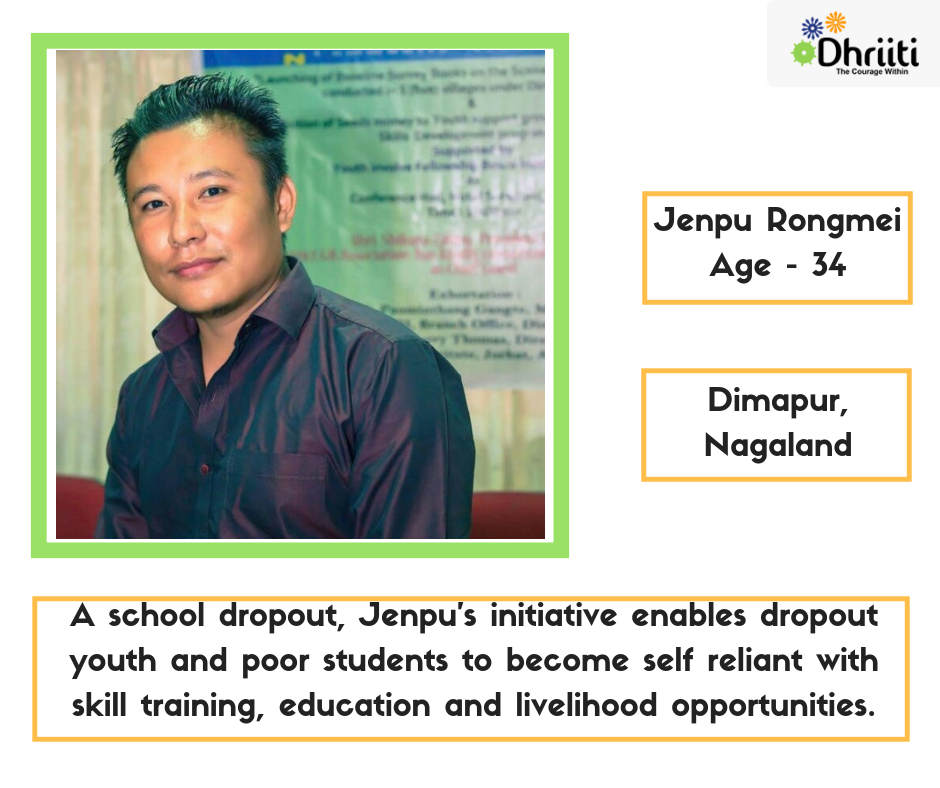 Jenpu is from Dimapur, Nagaland. Growing up, Jenpu has witnessed many hardships, which led him to the idea of ‘CAN Youth’. He believes it is his social responsibility to work with the youth and children living with difficult circumstances. CAN Youth was established in 2012 with the sole aim to support the inopportune dropout youth and students from below poverty line (BPL) in Dimapur district of Nagaland. The organization is currently focusing on establishing Information and Resource Centre to provide services on education, skill, job opportunity, and entrepreneurship through various avenue and linkages for sustainability development.
Jenpu is from Dimapur, Nagaland. Growing up, Jenpu has witnessed many hardships, which led him to the idea of ‘CAN Youth’. He believes it is his social responsibility to work with the youth and children living with difficult circumstances. CAN Youth was established in 2012 with the sole aim to support the inopportune dropout youth and students from below poverty line (BPL) in Dimapur district of Nagaland. The organization is currently focusing on establishing Information and Resource Centre to provide services on education, skill, job opportunity, and entrepreneurship through various avenue and linkages for sustainability development.
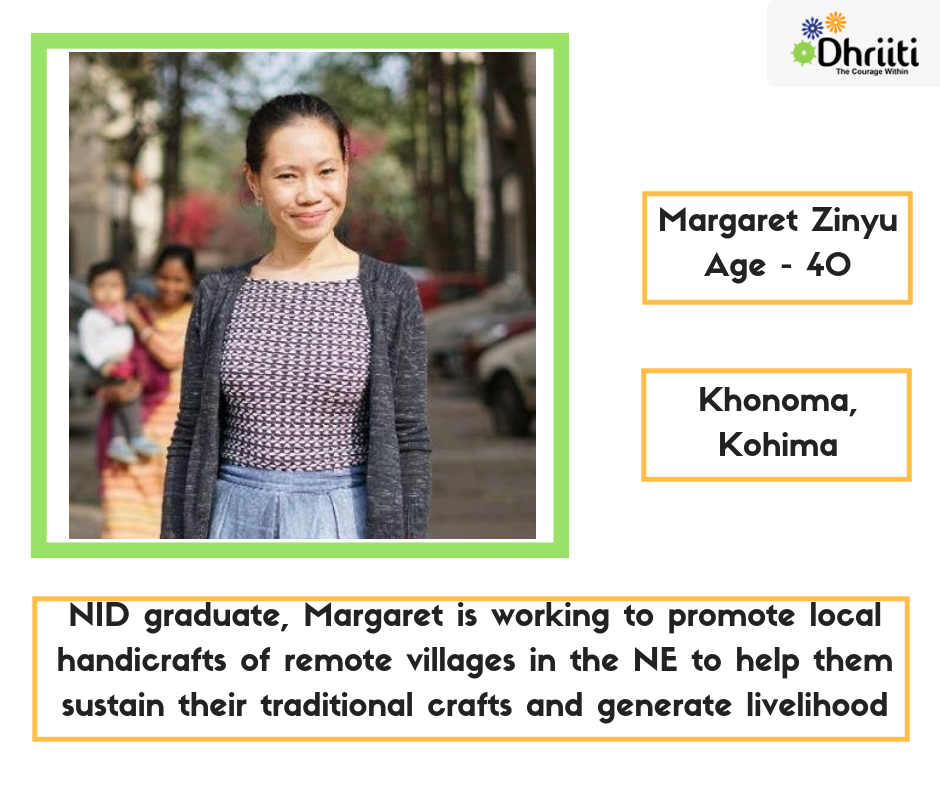 A NID Ahmedabad graduate, Margaret was always passionate about textiles. After working in the corporate sector of design for 8 years, she headed back home and decided to work in the craft industry. She set up Studio Predilection in 2015 with a belief that crafts is the second largest source of income for rural people in North East India and sustaining these skills as livelihood will create more employment generation. That way the indigenous traditions of Naga Crafts will also thrive for a better future. ‘Woven Threads’ is the label under Studio Predilection, which sells Handcrafted artisanal, contemporary, finesse, stylish and comfortable home furnishing products.
A NID Ahmedabad graduate, Margaret was always passionate about textiles. After working in the corporate sector of design for 8 years, she headed back home and decided to work in the craft industry. She set up Studio Predilection in 2015 with a belief that crafts is the second largest source of income for rural people in North East India and sustaining these skills as livelihood will create more employment generation. That way the indigenous traditions of Naga Crafts will also thrive for a better future. ‘Woven Threads’ is the label under Studio Predilection, which sells Handcrafted artisanal, contemporary, finesse, stylish and comfortable home furnishing products.
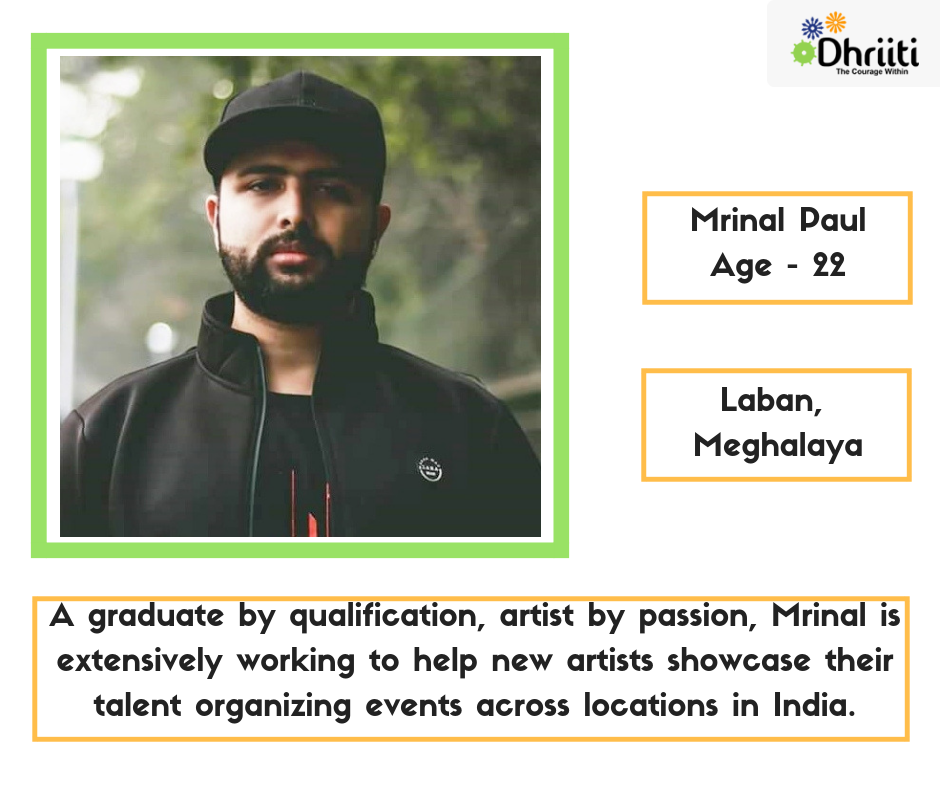 Mrinal, a graduate from Laban, Shillong, Meghalaya is an artist at heart and understands thoroughly the challenges that artists face. This led him to create an artists’ collective in 2016, which today has expanded into a talent and event management entity called MOX. The talent management agency is working with talents across the North Eastern region. MOX explores talents, builds their presence digitally, and curates LIVE opportunities for them to showcase their skills. The agency aims to showcase its artists across India and South-East Asia by next year.
Mrinal, a graduate from Laban, Shillong, Meghalaya is an artist at heart and understands thoroughly the challenges that artists face. This led him to create an artists’ collective in 2016, which today has expanded into a talent and event management entity called MOX. The talent management agency is working with talents across the North Eastern region. MOX explores talents, builds their presence digitally, and curates LIVE opportunities for them to showcase their skills. The agency aims to showcase its artists across India and South-East Asia by next year.
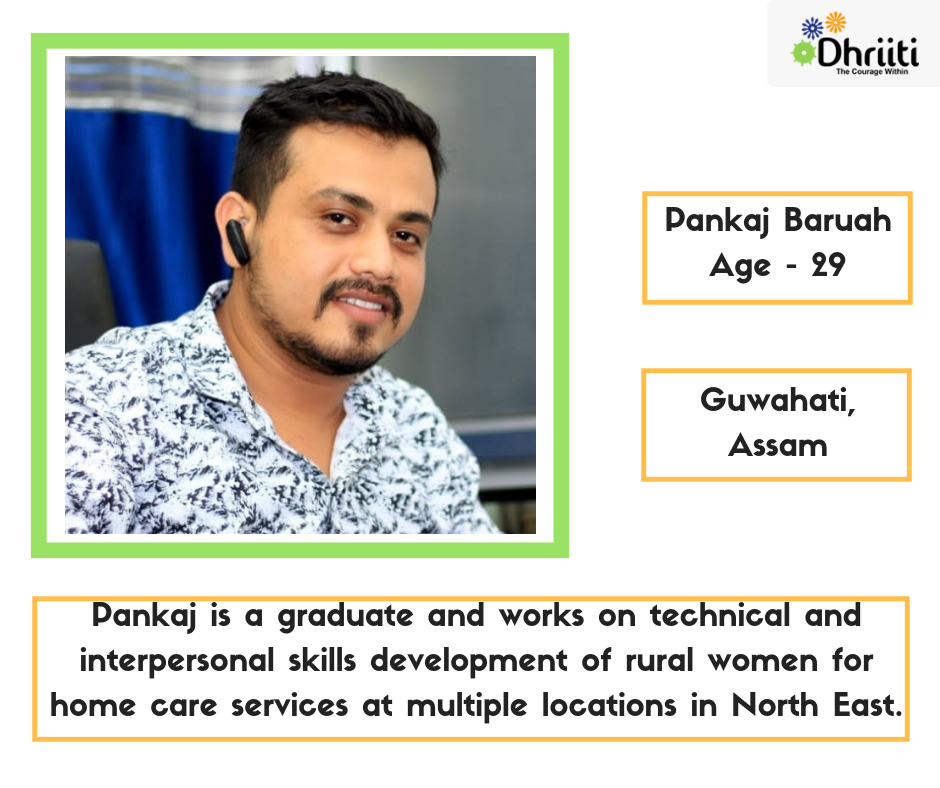 Pankaj is the Director of Maitri, a domestic service placement and management company which recruits, trains, and secures employment for women from underprivileged Northeast communities. “Sahayika” (caregiver in Hindi), the flagship program of Maitri is an initiative designed to build both the technical and interpersonal skills needed by domestic workers. The company also verifies that the prospective employer’s household does not have a history of issues with domestic service workers, sets clear expectations for the nature of work, and briefs the family on the prospective Sahayika’s background, skills, and employment preferences. Furthermore, Maitri takes this time to educate each Sahayika on her employee rights including a regular salary, paid leave, a bank account, and other benefits enjoyed by her service sector counterparts.
Pankaj is the Director of Maitri, a domestic service placement and management company which recruits, trains, and secures employment for women from underprivileged Northeast communities. “Sahayika” (caregiver in Hindi), the flagship program of Maitri is an initiative designed to build both the technical and interpersonal skills needed by domestic workers. The company also verifies that the prospective employer’s household does not have a history of issues with domestic service workers, sets clear expectations for the nature of work, and briefs the family on the prospective Sahayika’s background, skills, and employment preferences. Furthermore, Maitri takes this time to educate each Sahayika on her employee rights including a regular salary, paid leave, a bank account, and other benefits enjoyed by her service sector counterparts.
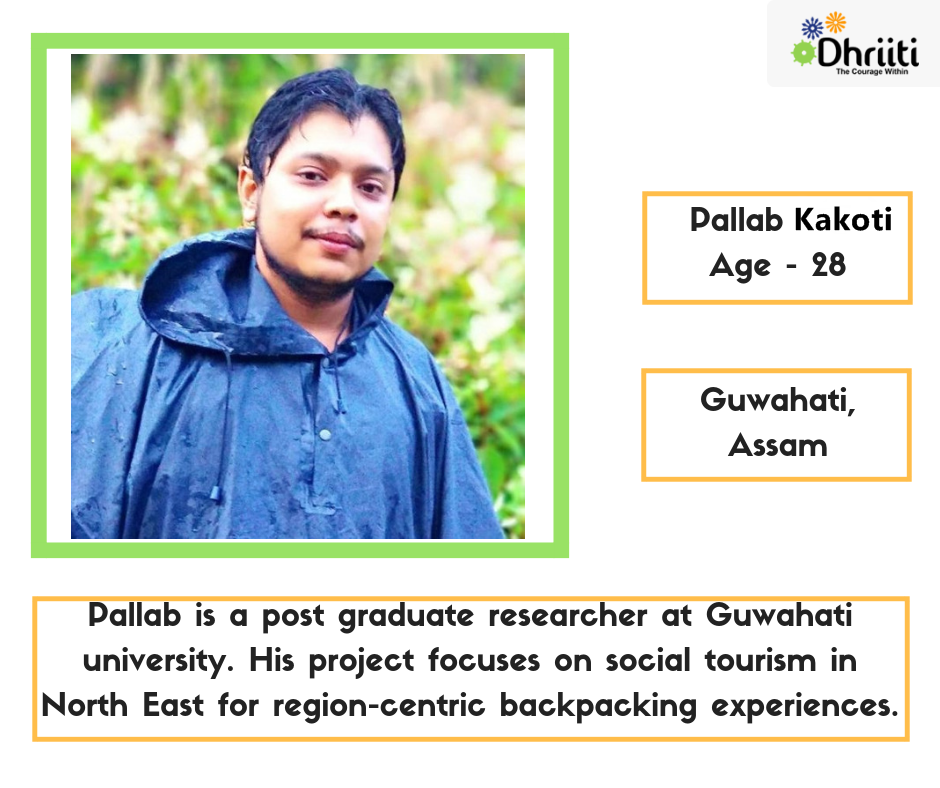 Pallab is a Post Graduate Researcher at Guwahati University. During the study of human capabilities, he realized that life is a constant pursuit of happiness. Some transcend to higher levels and associate their happiness with others. It was during a travel with his friends from abroad, who made him realize the potentiality of this region in terms of nature, resources available and the distinct yet varied culture. In 2017, he formed Eastern Wave, a community-powered tourism showcasing the culture and nature of Northeast India. Soon Pallab and his team started organizing camping trips and mainly catered to international backpackers as the company exactly offered the kind of experience these backpackers desire. Eastern Wave focusses on community-powered Tourism showcasing the Culture and Nature of Northeast India.
Pallab is a Post Graduate Researcher at Guwahati University. During the study of human capabilities, he realized that life is a constant pursuit of happiness. Some transcend to higher levels and associate their happiness with others. It was during a travel with his friends from abroad, who made him realize the potentiality of this region in terms of nature, resources available and the distinct yet varied culture. In 2017, he formed Eastern Wave, a community-powered tourism showcasing the culture and nature of Northeast India. Soon Pallab and his team started organizing camping trips and mainly catered to international backpackers as the company exactly offered the kind of experience these backpackers desire. Eastern Wave focusses on community-powered Tourism showcasing the Culture and Nature of Northeast India.
 An engineering graduate, Pratim has worked in the power industry for more than 7 years. He was actively associated with the technical and commercial aspects of the power industry. During his job stint, he realized the gap in the market and started working for the possible solutions to address those gaps. In 2016, he decided to become a full-fledged entrepreneur and founded Zinzid Technologies, which works with a vision to create technology solutions for sustainable development, primarily focusing on the energy efficiency of the customers and to reduce their environmental footprints. The company provides economic benefits to the customers, besides supporting the larger environmental goals.
An engineering graduate, Pratim has worked in the power industry for more than 7 years. He was actively associated with the technical and commercial aspects of the power industry. During his job stint, he realized the gap in the market and started working for the possible solutions to address those gaps. In 2016, he decided to become a full-fledged entrepreneur and founded Zinzid Technologies, which works with a vision to create technology solutions for sustainable development, primarily focusing on the energy efficiency of the customers and to reduce their environmental footprints. The company provides economic benefits to the customers, besides supporting the larger environmental goals.
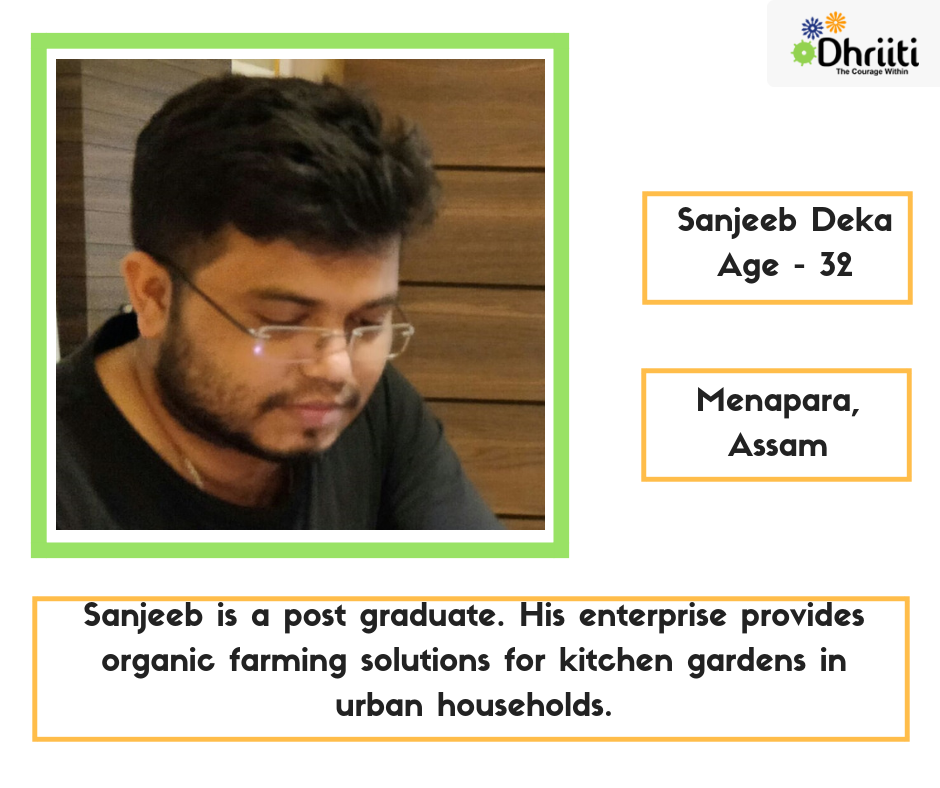 Sanjeeb comes from Menapara village of Daring district in Assam. After one of his family relatives achieved good health by using organic vegetables; he realized that organic vegetables have better nutritional value, improves health and also promoted to environmental sustainability. While working with Diya Foundation, Sanjeeb got an opportunity to practice organic farming in kitchen gardens in villages. He realized that urban households today are more inclined towards fresh organic fruits and vegetables. This idea gave birth to his venture, O-Kheti that presently sells a package of products and the services. The process is cost-effective and low-maintenance. Moreover one is aware that the best quality vegetables are being consumed by the family.
Sanjeeb comes from Menapara village of Daring district in Assam. After one of his family relatives achieved good health by using organic vegetables; he realized that organic vegetables have better nutritional value, improves health and also promoted to environmental sustainability. While working with Diya Foundation, Sanjeeb got an opportunity to practice organic farming in kitchen gardens in villages. He realized that urban households today are more inclined towards fresh organic fruits and vegetables. This idea gave birth to his venture, O-Kheti that presently sells a package of products and the services. The process is cost-effective and low-maintenance. Moreover one is aware that the best quality vegetables are being consumed by the family.

Plastic ban: An opportunity to encourage ecological and economic growth
The need of eco-friendly products has never been so important than today when plastic has already choked our cities, oceans, and mountains. This year on World Environment Day, the entire world took a pledge to ‘Beat Plastic Pollution’ to combat one of the great environmental challenges that our generation is facing. Continuing the resolution, Maharashtra, and Uttar Pradesh states banned the use of plastics in July while Odisha government has planned to implement the rule from October month. This comprehensive plastic ban also includes disposable cups and plates, cutlery, and packaging. Hence, the products made of natural resources like leaf, coconut, and wood have caught the attention of everyone these days.
Plastic waste has become a major concern in urban areas and people now are looking for options to replace the plastic cutlery with recyclable products. This rising demand of eco-friendly products has created entrepreneurship opportunities for people in rural and semi-urban areas. To boost small enterprises, many corporates and NGOs are also providing technology and skill development programs that help people in their entrepreneurial journey and build a community of rural entrepreneurs. New Delhi based NGO, ‘Dhriiti – The Courage Within’ is working towards its mission of transforming communities by developing entrepreneurial skills in people from diverse socio economic backgrounds.
Dhriiti works with entrepreneurs who identify and convert opportunity into sustainable enterprises to enhance the quality of livelihood. The organization nurtures, incubates, and support potential entrepreneurs through its innovative and professional approach. It endeavors to promote entrepreneurship in different forms and build a spirit of entrepreneurship amongst the communities. With its ‘Financial, Social, Ecological (FSE)’ concept, Dhriiti works with aspiring entrepreneurs who can build transformative enterprises to protect the environment and bring a positive change in the society.
The organization understands that rural areas have great potential but people face challenges like limited access to finance, gaps in skills, unfavorable business environment; low financial sustainability, and lack of planning. Dhriiti team aims to meet such challenges and promote small industries by applying modern management and technology tools. The organization is running various skill development and entrepreneurship projects with support from corporates and state governments. As a part of its endeavor for North East India, it has been working on ‘Arecanut Leaf Plate Manufacturing Cluster Development Project’ in Assam.
More than 500 micro enterprise units have been set up under this project to make disposable plates and bowls from the sheath of arecanut trees. Till date, the project has trained more than 5000 people and has engaged 7000 families in North East India. The enterprise has created a positive impact on region’s employability percentage as each unit provides employment to more than 20 rural youths. ‘Tamul Plate Marketing Pvt. Ltd. (TPMPL)’, an institution created under this initiative manages the whole operations in a commercially sustainable manner.
Today, TPMPL markets the high quality products at national and international level under the brand name, Arecana. The project has been the most successful program wherein Dhriiti nurtured the entire project for 10 years and handed over operations to the producers’ institution. Going forward, the program has a vision to build a micro enterprise value chain worth INR 100 crores in North East by 2020.
Additionally, to further push the growth of eco-friendly industries, Dhriiti is working on its ‘Sal and Siali Leaf Plate Cluster Development’ project supported by Odisha Forestry Sector Development Project (OFSDP), Government of Odisha. The project is aimed towards the development of innovative product designs for high end urban areas as well as the international market. The project aims to become a people’s institution in next five years boosting the Sal and Siali leaf plate manufacturing in the state. Dhriiti team will be working with Sal leaf plate producers in two blocks of Keonjhar and Rourkela. The project will be amplified further as a full cluster development program in partnership with various public and private bodies.
Needless to say that making eco-friendly product from leaf and other natural sources not only supports the underprivileged community but also helps in saving environment and reducing wastage. As the plastic is badly affecting our health and surroundings, the use of eco-friendly products has become more like a necessity than a choice. By adopting sustainable habits and promoting eco-entrepreneurship, we can surely give a gift of health and happiness to our next generation.

BECAUSE MY FATHER DID NOT CHARGE HIS PHONE, I AM ON THE RIGHT TRACK
A week ago I was stuck in traffic and my mind was doing what minds do best, wandering. I started analysing the chain of events that led me to where I am in my life today.
The only reason I am where I am today is because my father did not need to charge his phone on a particular night.
With a line like that, a back story is required so I will have to go into some detail about my personal life. But not too many details because… you know… Mark Zuckerberg.
Every year, Indian Oil conducts an awareness campaign about conservation of oil and natural Gases. Our family business is associated with Indian Oil so we are very much a part of organising and participating in the awareness campaign. We make it a point to have at least one person from the family attend the various activities and events that are organised. One of these events is a mini-marathon. Ever the sportsman, my father was to attend the marathon on this particular occasion, but on the night before, he got a message at around 11.30pm, informing him of an important meeting the following morning. Guess who was informed that he was required to go to the marathon instead of him? (answer at end of blog)
I am a night owl by nature. I usually stay awake till 3 to 4 am, working on whatever project I am obsessed with at that moment. I find that those hours give me adequate peace and tranquillity to do my thinking and execution (not literal executions). The obvious fallout of this is that usually I wake up by 10 or 11 am. But I need my 7 to 8 hours of sleep otherwise I spend the following day looking like a zombie having a bad Hair Day.
So naturally having to wake up at 5:30 A.M for any reason is usually a kicking and screaming affair. The cherry on the cake was that if my father had followed his nightly routine of charging his phone in the other room, he wouldn’t have received the message at all and all this could have been avoided.
So I turn up reluctantly for the marathon and begrudgingly run the race, throwing dirty looks round indiscriminately. Immediately after the race, Indian Oil had also organised a drawing competition for children below the age of 12. Since the competition had to have a theme, (oil and natural gas conservation) there was a certain amount of explaining to do to the children. Indian Oil had hired a qualified and competent emcee to handle this. Qualified and competent though he may have been, reliable and punctual he was not. He did not turn up. In disaster management mode, an official from Indian Oil suddenly says “Rick, why don’t you do it. You are an artist so…”
I personally really look up to this gentleman and didn’t want to let him down, so I agreed. The begrudging, dirty looks throwing, bad Hair Day having, zombie resembling emcee suddenly has a microphone in his hand and finds himself explaining the apocalypse to a bunch of disinterested children.
As luck would have it, one of the participants happened to be the daughter of a program director from All India Radio. After the event, she came up to me and said she really liked how my voice sounded on the amplifier and asked me to apply for a job as a radio jockey on the spot. To be fair, I thought she should have offered the job to the amplifier instead, but hey, we take what we can get, right?
I started work at All India Radio and over the course of the next few months, I got the opportunity to cover various events happening in and around Shillong and to conduct interviews with some very interesting people.
One of the events I covered happened to be a film festival in Shillong. The producers had booked a slot to interview an actor and had chosen me to do it. It should be noted that there is a pool of some 20 other talented broadcasters, so the chances of me covering that event were 20 to 1, at best.
On the appointed date and time, I arrived with the producer and the technical team. But as it turns out, the actor was stuck in traffic and would be arriving late. So I found myself sitting around, engaging in small talk with random strangers (I was saving my big talk for the interview).
One of these random strangers happened to be an artist. I am an Aspiring artist myself so we instantly bonded and developed a casual, easy friendship. As we got to know each other and began to swap stories and share ideas, I told him about my entrepreneurial enterprise of starting a makerspace and how I have been working towards the concept with almost every fibre of my being. At that point I had been working towards the concept for the last 3 years. I had worked to learn and understand the various skills and improve my knowledge base and I was at the funding stage. Here’s how that conversation went.
Me: … and thing’s are getting pretty frustrating. I don’t know how much I don’t know and I don’t even know where to start.
Him: Ya, Bro. And bro, i have experienced that most people are very unhelpful.
Me: I know. Jealousy is a mental cancer. (at this point, i smiled smugly at my philosophical kung fu.)
Him: Bro, i read that quote too. B. C. Forbes, right?
Me: … yes.
Him: Well bro, I am attending a workshop next week sometime. Its about business, or getting investment or something. Bro, you should come…
Me: I’m probably busy, but I’ll think about it..
Next thing I know, I find myself sitting for a workshop by Dhriiti. It gradually became apparent that they were focussed on helping the participants. And that help was extended on a very deep and personal level. They wanted to get us to go where we wanted to go. Not where they thought we should go, as is usually the case with “experts” and “consultants”.
For someone who has had to hustle for information from those who mistrusted my motives, learn things the hard, slow way, ask for guidance only to be ignored, and discouraged from the happiness that comes from the pursuit of happiness, I could not believe the goodwill and sense of belonging I found within a room of strangers. We were united by one thing. Faith. Faith that the path we chose was beneficial and would help us grow. Faith that we could and would learn whatever was required of us. Faith that even though being pro-active is fraught with failure and ridicule, it is far nobler to try and fail.
At the same time, I was blown away by the randomness and blind luck in the face of astronomical odds that has now put me in touch with this organisation.
So what am I trying to say?
The world works in mysterious ways and an insignificant event can trigger a chain reaction that could be the difference between a life you choose to live and a life that you are compelled to live. If my father’s cell phone was charging in the other room, which is usually the case, he would not have gotten the message about his engagement and I would not have been forced to show up for that marathon.
If the emcee was on time I would not have been forced to speak on the microphone.
If the program director from All India Radio did not happen to be there or for any reason, did not come up and speak to me, I would not have become an RJ.
If the film festival was assigned to a different broadcaster or if the actor had been on time I would not have gained a new friend.
If for any reason that conversation between us would not have happened, I would not have associated myself with Dhriiti.
If I have not met dhriiti, I would not be on this concrete path where is leading me to my goal.
Make no mistake, person reading this. This is not a veiled promo for Dhriiti. There is no guarantee that anything will come true or that success is about finding smart/successful/influential people and copy pasting their formula. In fact, failure is likely and success is more of an exception to the rule. But failing with the right people is preferable to succeeding with the wrong ones..
Moral of the story- Be open to the world, participate, speak to strangers and don’t make assumptions. Be specific in your vision but flexible in your path.
Burying yourself in your cell phone, being half present in the real world is not very different from actually and literally burying yourself. The chain of causation is impossible to predict and our world is chaotic and difficult because of this. Embrace the chaos, bro.
(Answer: Me.)
About the Author: Chancharick Choudhury is a sculptor, radio jockey, event management consultant and aspiring entrepreneur from the hills of Shillong. His mission in life is to bring current technology into the service of each and every member of society. His cheese omletes are legendary.

Experiential learning via nature Based activity
A lot has been written on what is entrepreneurship? How do you become a successful entrepreneur and various success mantras on it..
Every one has his or her side of the story to write or tell on what it takes to be an entrepreneur… So do I! It might be reinventing the wheel but well there is one thing which I have realized that has made me stay put in my journey of an entrepreneur… I have believed in one statement “Do your work, don’t worry about the results” as stated in Bhagwad Gita. That’s the fact of life… If one makes this statement as his/ her foundation of life, it becomes quite easy to overcome every challenge that comes our way…
Well what this statement really means, is enjoy the process/ steps/ journey… results or your destination will be reached depending on the steps one took during the journey. Entrepreneurship is also the same.
When one decides to become an entrepreneur one needs to have a few things clear in his/her mind in the following order-
Question1. Why am I taking this journey?
Be really honest with yourself. This is your journey nobody else’s. Challenges and problems coming in your own path have been created for you and only you can solve them… No one will be able to give you the right answers. You need to be super clear in your head if you are ready to face these questions all by yourself. After all everyone will be there to tell you, either sugar coated or as a bitter statement, ” It was your decision, now face it… we cant do much about it, because we have not gone on that forbidden path…” So remember its not for weak hearts and dishonest people. (dishonesty with oneself)
Question 2. If you have the answer to the above question then its time to probe further- What am I gonna do? What is it that will keep me hooked on even when things are not working for me… Trust me it might take years before you really get cracking…. So be very clear and again do that heart to heart talk with yourself what is that you really love or are passionate and are willing to fight for against all odds to get it right. Trust me entrepreneurship is not about money… If you think you will make more money by becoming an entrepreneur, then my dear don’t take this path.
Entrepreneurship is about freedom to do what you think is right! Its freedom from the mundane life! Its freedom from taking orders! Its all about creating new paths which world is yet to see.
Question 3. Last question to answer- How do you plan to take this journey?
You have a job! People are dependent on you, how will you sustain yourself and others? This is the toughest question to answer… But trust me if you have answered the above two questions honestly, you will manage your way out.
When you begin the journey of being a true entrepreneur you will be required to continuously ask yourself these questions as challenges will keep cropping every day in some way or the other… its these questions and their honest answers which will help you move forward in your journey, it might be slow or fast, but you will move forward. You have to constantly keep asking these questions in the same order for any kind of challenge you come across in this beautiful journey to help you reach your destination.If you are asking why, then answer to that is also simple, you are the only one who knows the destination, everyone else are just following you… so they are dependent you and are ready to follow the path you are going to take… After all entrepreneurs are the real innovators and find a way for the rest of the world.
Original content of the above blog can be read at: http://explearningvianature.blogspot.in/2017/11/decoding-entreprenurship.html
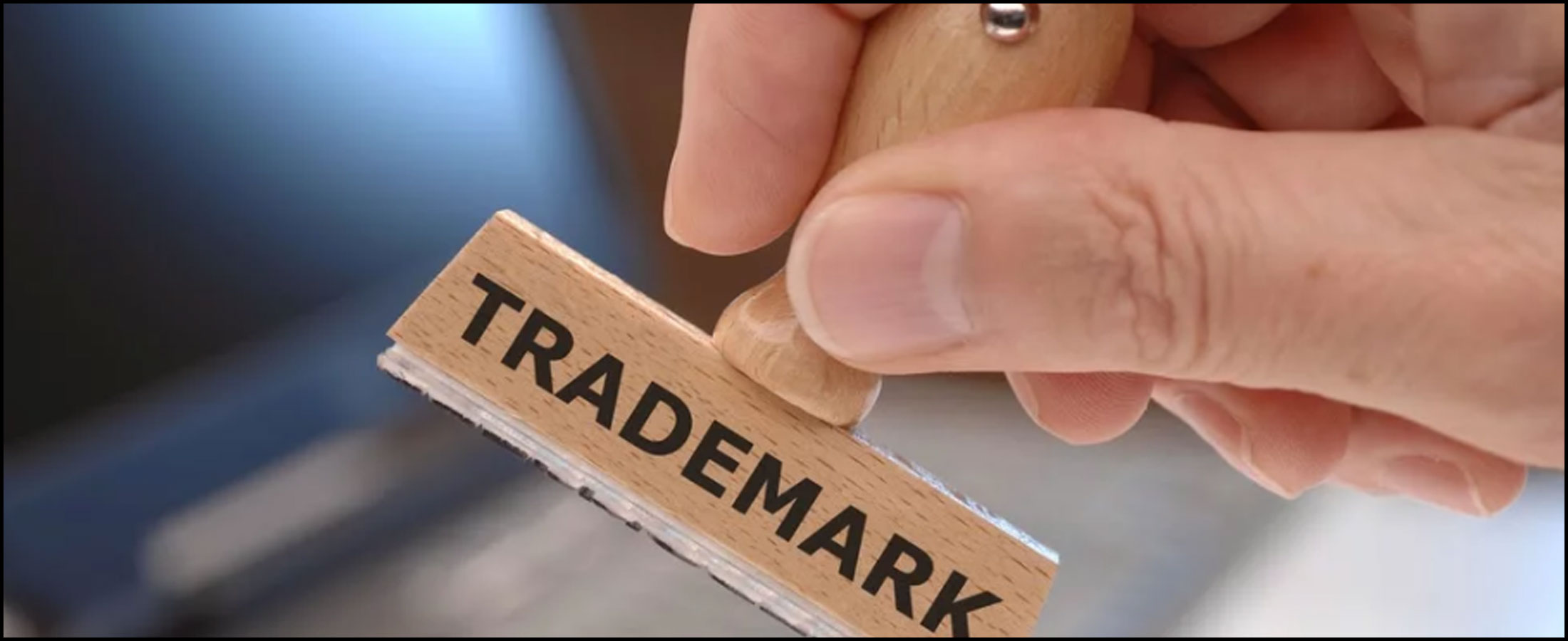
What are the steps involved and the costs to register a trademark in India?
The official fee charged by the Indian trademark office is Rs.4500 (Individuals, Startups and Small and Medium Enterprises – SME’s) and Rs.9000 (for others) per mark per class. The professional charges start from Rs.1999 and upwards depending on your service provider. It is as simple as deciding to have pani poori from your street corner vendor or having it at a five-star hotel. What’s important to be considered in choosing your service provider [as with any service] is the experience and quality of service one offers.
Your brand is the most valuable asset of your business and you should take some time to choose the right service provider. You can ask your service provider to provide you with a list of trademark they have helped register. Trademark records and their details are made available to the public and your service provider should be able to provide you this without any hassles. You can then cross check a few application numbers at the Indian trademark office website by keying in the application numbers.
Another major issue faced by trademark owners in India is that every tom dick and harry offers trademark filing. Yes, they offer filing, not registration. While I appreciate the fact that several designers, domain name registrants, accountants, engineers, and CA’s offer this as an extended service to their clients, it is unfortunate that quite a few of these service providers learn trademark law at the cost of their clients. It is also important to understand that obtaining a registration for a trademark in India involves several steps and it is not merely a form filling job. You should ask your service provider to provide you with the other costs, if any, from filing to registration. In many cases the trademark owner is in for a surprise with additional costs at a later date when objections are raised by the trademark office or oppositions are filed by third parties.
Let’s understand the steps involved in getting your trademark registered in India.
- Selecting a mark
- Classification of goods or services
- Search the trademark office records
- Filing the application
- Responding to objections from the trademark office
- Advertisement in the trademark journal
- Handling opposition by third parties
- Registration
- Maintenance or Renewal
Selecting a trademark is one of the toughest job for the trademark owner. This is going to be your brand and changing it later is not going to be easy. After several brainstorming sessions, you choose the right brand name for your business. Now that you have come up with a brand name it’s important to do a trademark search.
Classification of goods of services is very important for you to protect your trademark for the right goods of services you offer under your trademark. It is important that your service provider understands your business well before deciding to select the classes in which the trademark should be protected. For example, your trademark will fall under difference classes if you offer web app development services vs having an app for the purposes of selling goods online.
Trademark Search is the process where the records of the trademark office are searched for the same or similar marks in the classes of your choice to see if anyone has filed for similar marks earlier than you. Additionally, it is advisable to do a general Internet search as well. Several countries including India are not a first to file but rather a first to use country. This means that whoever uses the trademark first gets more rights than the one who filed for an application with the Indian trademark office.
Thought trademark rights are territorial, technology has made the world a small place. Hence, it is advisable to run a Global search in whichever jurisdictions possible. Several trademark office databases are available online with free access.
A good thumb rule we follow at our firm is to check if a .com domain name is available for your trademark. If it’s not available, then it’s a red flag that needs to be considered. Many times, the domain names are merely parked and not used.
Costs for a trademark search: [Professional fees range from Rs.500 to 2500 per trademark per class along with a professional opinion+ No official fees.]
Filing the application may be one of the easiest one once the above steps are done properly. It’s like as getting your foundation in place before you start building your house. However, it is important to put in the right information in your application to avoid any objections by the trademark office on a later date. This obviously comes with experience.
[Professional fees range from Rs.999 and upwards per trademark per class + Rs.4500/9000 as official fees per mark per class.] Timeline: 1 to 2 days.Objections are raised by the trademark office when they examine your application to register your trademark and the same should be responded to and complied within one month from the date of such objections. Most of these objections can be avoided when the same is foreseen at the time of classification and trademark search by your service provider. This not only saves costs but a lot of time in the process of getting your trademark registered in India.
[Professional fees ranges from Rs.1499 and upwards per trademark per class. No Official fees] Timeline: 1 to 2 months from the date of filing your application.Advertisement of the application in the journal is because any third party can oppose to the registration of your mark on several grounds. The most common one being that your mark is like their mark. Opposition proceedings are long and costly and could be avoided by following the right strategy before filing the application. Timeline: 4 months from the date of advertising the application.
Registration is granted in the absence of any opposition within 4 months from the date of advertisement. The registration is valid for a period of 10 years from the date of the application. You should start using the ® symbol on your trademark immediately. Timeline: A week after expiry of the opposition period and in
the absence of any opposition.
Renewal of a trademark in India can be filed six months prior to its expiry date. The renewal grants another 10 year protection to your rights on your trademarks. [Professional fees range from Rs.1999 and upwards per trademark per class + Rs.9000/class as official fees per mark per class.]
Your brand is your most prized asset and trademark rights are perpetual. It should be carefully coined, protected, and maintained. When you decide to file for an application to register your trademark keep these in mind in choosing your service provider.
If you have something to add to this article or comment on the same feel free to comment below or reach out to me by email.
Original content of the above blog can be read at: https://selvams.com/blog/steps-involved-costs-register-trademark-india/

Trade Marks Rules, 2017 – What it means for Startups & SME’s
The Controller of Patents, Designs and Trademarks through a public notice dated November 19, 2015 brought to the notice of the public the draft of the Trademarks Amendment Rules, 2015 proposing to amend the Trademark Rules, 2002 and had invited comments from the public and stakeholders within 30 days from the date the notification published in the official gazette of India. At last, the Trademarks Rules, 2017 came into effect on March 06, 2017 with several changes ranging from increase in official fees, discount for online filing of trademark applications, hearing through video conferencing, maintaining a list for well-known trademarks among other things.
While this post will cover only the amendments with respect to startups and small enterprises (SME’s) you may also check out posts from my colleagues in respect of the journey of the trademark office from paper filing to digital, practical aspects of the online trademark filing system, increase in the official fees to an extent of 125% and changes in the rules in general and the reduction of the number of the trademark forms.
The new rules offer 50% discount on the official fees for startups and SME’s (small and medium enterprises) with respect to filing an application for registration of a trademark and for expedited processing of an application for registration of a trademark. Filing an application for registration of a trademark is Rs. 5000 (Paper Filing) / Rs. 4500 (e-filing and expedited processing of an application for registration of a trademark is Rs. 20000 (e-filing only)
The applicant should be recognized as a startup by the competent authority under the Startup India initiative. To qualify as a small enterprise, the applicant’s investment in plants and machinery alone should not exceed ten crore rupees if the applicant is a manufacturer. However, if the applicant is a service provider, the investment in equipment in general should not exceed five crore rupees.
Unlike the Indian Patent Amendment Rules, 2016 where the applicant being a startup/individual/SME enjoys discounted costs for the entire life of a patent application and even subsequently thereafter, in respect of renewal of the patent, the Trademark Rules, 2017 has limited the discounts with regard to Startups/Individuals/SME’s only filing and expedited examination of the trademark application.
The other amendment that startups might find useful is the ability to request amendment of the specification of goods and services in the event of them being wrongly classified at the time of filing the application. On several occasions, entrepreneurs and applicants file applications on their own or using a low-cost filing service provider which may not have an experienced lawyer to classify the specifications of goods and services. When the trademark office raises objections on erroneous classification, the only option earlier was to file a fresh application or delete the specifications objected by the examiner. However, the amendment now provides for splitting the classification and adding new classes to the present application. This will save the applicant from losing time and priority by filing a new trademark application.
Original content of the above blog can be read at: https://selvams.com/blog/trade-marks-rules-2017-means-startups-smes/

New initiatives from the copyright office for registration of copyrights in India
Digital technology is drastically changing our ways of life, whether it’s home or office and the Copyright office is no exception to it. In its attempt to use the technology and to enhance transparency in Copyright prosecution in India, the Copyright Office recently issued a Public Notice wherein stating that the Copyright Office going forward shall publish on its website a list of all applications received by it for copyright registration. The said list shall be published on the first Friday of every month.
Recently, the Government of India has shifted the Copyright Office under the control of the Department of Industrial Policy & Promotion (DIPP) which operates under the Ministry of Industry and Commerce. Now, DIPP has control over Copyright Office in addition to the Patents, Designs, and Trade Marks Offices. Over the years, the Trade Marks and Patents Offices have been publishing the accepted applications in weekly Journals respectively and on similar lines, the Copyright Office has now initiated the monthly publication of copyright applications.
Under Indian Law, copyright comes into existence the moment a work is created. However, the copyright registration provides you with the statutory right to have the work protected under law and it constitutes prima facie evidence in case of a copyright infringement. In order to have a copyright registered, the Applicant has to follow the procedure laid down in the Copyright Act and Rules thereunder.
As per Rule 70 (9) of the Copyright Rules 2013, the person applying for registration of a copyright shall give notice of his application to every person who claims or has any interest in the subject matter of the copyright or disputes the rights of the applicant.
In lieu of the said provision, this publication of a list of applications by the Copyright Office would be treated as a notice. Post-publication, the copyright applications shall be open to objections from third parties for a period of thirty (30) days from the date of availability of the said list to the public and in the absence of any such objection being raised within the prescribed time, the copyright applications shall proceed towards examination.
However, in the event an objection is raised by the third party, the Applicant would be required to submit the corresponding documents/response with respect to his copyright application, failing which the application will be treated as abandoned.
This initiative regarding the publication of copyright applications is a significant step forward towards bringing in, the digital technology in intellectual property registrations. The Copyright Office has taken the attempt in order to ease the procedure of Copyright registration in India and consequently, it also paved way for speedier disposal of the applications. The innovative approach of following the procedure of giving notice under the said rule would definitely give relief to the Applicants of Copyright registration.
Original content of the above blog can be read at: https://selvams.com/blog/new-initiatives-copyright-office-registration-copyrights-india/

Why Startups need to protect their Intellectual Property before disclosing it
Intellectual Property – Creations of your Mind
‘A hundred and one wonders our mind holds,
And out of it rarely a creation unfolds!’
Isn’t that true? Imagine you have created something ingenious, what we formally call “Intellectual Property” or simply IP, like a truly mind-blowing technology/invention or an original design or a very simple yet original poem like the one above. So what would your next step be? Simply cherish the IP and give it all up for the others to use (the right word here is “misuse”) or protect the IP in the way it should be?
Start-Ups and IP
Of course, the above scenario holds good for any person; but it is all the more important if you are a Start-up, fresh into an industry, trying to make your efforts count, especially where your business involves dealing with IP. Moreover, as a Start-up, you may have the zeal for business, yet being new, you may not possess a clear idea about the implications your Intellectual Property might have on your business.
Why Protect IP
You may naturally have second thoughts about protecting your Intellectual Property and several questions may arise, such as-
- Is the IP valuable enough to be protected?
- Why take/waste the efforts and resource to protect the IP?
- What if I stay put and simply enjoy the IP?
All the aforementioned questions are answered below.
Is the IP valuable enough to be protected?
A Start-up’s IP may be anything ranging from a newly invented know-how/invention that is banked upon to run the very business or simply the brand which would be the identity of the Start-up or some creative content like literary, dramatic, cinematography, artistic or sound recording work. These are only a few broad examples. In all the cases, your Start-up would revolve around your IP in one way or the other and managing and protecting the same might actually decide the ground for you.
Why take/waste the efforts and resource to protect the IP? What if I stay put and simply enjoy the IP?
Let’s take an interesting example – Imagine you have invented the transportation machine by which you can get transported from one place to another within moments (a.k.a Harry Potter style). Obviously, you would intend to cash in on the said technology/machine and you decide to enter into a Joint venture with another entity and disclose all the details relating to your machine/technology in good faith without any reservation.
One fine day, you may find that a partner or collaborator decides they no longer need you in the project, and to your surprise, they’re already moving forward to leverage the technology, claiming ownership over it. It’s a familiar scenario that many innovative startups face, with ideas or technologies being taken over by more powerful entities. In such cases, a legal battle is always an option, but these can drag on for years, often with detrimental effects on a small business’s survival. Instead, learning to secure intellectual property early on or choosing trustworthy partners can help protect your innovations. In this way, startups can prevent falling prey to larger entities acting as a slot monster casino draining resources without fair play – and can instead focus on thriving in a competitive landscape.
Another example – You have created a brand/mark for a product and your whole business revolves around it. But getting trademark registration for the mark/brand just slipped your mind and then out of the blue, you come across another mark which has an uncanny resemblance to your own brand. With no trademark registration backing for the mark, you will have to battle with the other party to prove that you are a bonafide owner of the mark and that you are genuinely using it prior to the other person.
Another scenario is where you author a book or create a design and in each case, protection of the IP becomes crucial. Else it is better to be prepared for third parties to hijack your IP and more importantly, the financial openings that your IP would have laid at your doorstep.
The Reasons in a Nutshell
1) Your IP is your brainchild and for this sole reason, it deserves protection.
2) Your very idea of initiating a business/Start-up might have sprung from your IP or in due course, your Start-Up might come to bank upon an invention or a trademark or other original, creative content. So even to get the Start-up thriving and running, protecting your IP is imperative.
2b) As a joinder to the above, your IP might be capable of financially feeding you and your Start-up like royalty for invention licensed to a third party or a franchise and continued protection of the IP is what ensures that the financial inflow does not cease.
3) Where you disclose your IP to third parties without protecting it first, you would only engage in legal battles to prove your ownership to the IP, which is not only time-consuming but will end up swallowing your very Start-up with the financial burden, not to mention the mental agony it brings with it.
Hence it would be prudent to take the effort and protect your IP as soon as creating it rather than disclose and take desperate efforts to hold on to it later.
There is no end to IP protection
Be it a Patent, Trademark, Copyright, Design or other forms of IP, the protection process does not end as soon as you register the IP. IP protection is a continuous process. For one, renewal of your IP (where applicable) as and when it arises, is a must do. Comprehensive information on renewal of trademarks by my colleagues could be found here.
Once you have an official entitlement to your IP, the next step is to stay vigilant to ensure that no person attempts to hijack/infringe it, let’s say by using similar technology/deceptively similar mark/similar piece of work. This is in most cases, entrusted to IP counsels who would have a better idea as to what might pose a threat to your IP. In this situation, you have a better edge since you will not have the necessity to prove your title, which is the most important point to be established.
Driving home the point, in respect of trademarks, where a person has a registration for a mark and a third party has a mark deceptively similar; a suit for infringement (more about infringement could be found here) can be filed and in such a suit, only the deceptively similarity is required to be proven. On the other hand, where the mark is not registered, a passing off action can only be initiated, in which case, not only deceptive similarity, but likelihood of deception/confusion is also required to be proved. This of course is certainly not an easy task.
IP for Inviting Problem or Invaluable Protection
The above would certainly give a fair idea as to why it is imperative to protect IP before disclosure to any person. And there are various ways to protect your IP which would, inter alia, depend upon the nature of IP and other surrounding factors. You could always write to us to know ways to protect your IP. You could either protect it or wait for others to protect it..in their name of course.
Original content of the above blog can be read at: https://selvams.com/blog/startups-need-protect-ip-disclosing/

Paper Works !!!
In a candid chat with Pooja Sriram, owner, Orange Peel, she tells us how social networking and word of mouth are some simple yet creative promotional strategies for business ventures.
Pooja, a 26 year old entrepreneur always had an eye for things unique and creative! “Orange Peel, is one of those creative ideas that actually progressed from an idea to a product and now a business.” Orange Peel is like her in-house creative incubator where, she with her mother and sister, creates beautiful jewellery mostly earrings for now, made from paper in vibrant colours.
“Orange Peel was born in March 2013, just like a hobby. With more people appreciating our work, we decided to name our brand. Before we knew it, we had a logo, a full-fledged Facebook page and several ‘likes’ pouring in! Orange Peel is that little nut-shell that has integrated my love for colour, creativity and social networking.”
Orange Peel also offers Pooja a canvas to bring forth her photography skills as well as marketing tactics. Her large network of friends and acquaintances are now her customers and sure her teachers are proud to see her put the knowledge imparted to use.
What inspired you?
The idea was a pure result of a visit to the many Santes and flea markets that are held in Bangalore. The idea of making paper jewellery is not new; but our products are 100% handmade and the efforts put in to come up with new designs, unique colour schemes, and attention to detail, make us different from the rest. And for the sourcing of material, I am thankful for Mom’s bargaining skills that make the procurement of materials an easy task!
Who are your target customers?
As of now Orange Peel only has paper jewellery which makes women our target customers. We have girls as young as 4 to women as old as 60 buying our products. However, we also have some adorable men buying these as gifts for their wives, girlfriends, daughters and moms! We have plans of expanding our portfolio with hair accessories, key chains, magnets, home décor products, etc and hope to have a more diverse group of customers.
What is the marketing model that you follow?
Orange Peel started just 3 months ago and all our marketing is through word of mouth and the god of all social networking sites – Facebook. Using our own PR skills and Social network Orange Peel has had more than 200 likes in 2 months and the page had more than 3000 views! One strategy that worked for us was to get single boys to buy or promote Orange Peel products with all the girls at their workplace.
How do your customers get the products since these are small goods purchased online?
I like meeting my customers. I either get them to pick it up from my homes, we work from both my Mom’s and Mother in Law’s place, or I meet them and deliver it to them. In case of orders overseas, I have got relatives and friends travelling to deliver my little packets. With our orders increasing, we will soon start couriering them.
About the Author: Pooja Sriram pursued her MBA in Advertising & Marketing Communication from the Manipal Institute of Media and Entertainment (MIME) and is currently an Associate Manager- Product Marketing at a Global Mobile VAS organisation- Onmobile Global Ltd. Orange Peel products range from Rs.29-Rs.149. Check them out at www.facebook.com/orangepeelswirlart
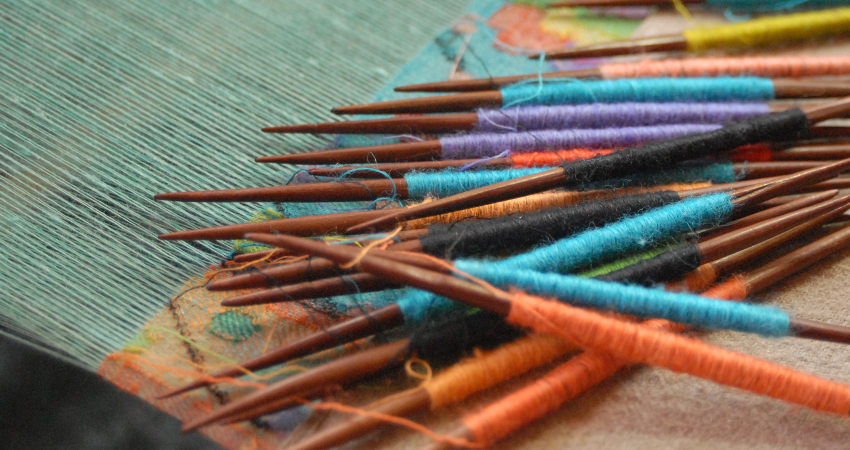
The Cashmere Touch of the Pashmina
Most of us who are able to look beyond the insurgency in Kashmir view it as a place with immense natural beauty – a land of stunning lakes and mountains! Nothing epitomizes the glorious history of the Himalayan craftsmanship, as warmly and beautifully as does the Pashmina. Pashmina, prized by kings and nobles and the pride of a bride’s trousseau even now, is often referred to as the ‘diamond’ of all fibres. The artisans of Srinagar narrate the stories of their forefathers who served the Mughals and made a single shawl in a 6-12 month period. Even today their fine art exists and some shawls take months to be completed.
The splendid craftsmanship
Pashmina mainly comes from the Himalayan region and is known for its warmth and long life. The uniquely soft fleece is hand-combed every spring from the soft wool from the neck and chest of the Capra Hircus, the Himalayan mountain goat. These goats are reared in herds at altitudes over 14000 feet in the arid plateaux of Ladakh, Tibet and Mongolia. The thermo conductivity of the wool is one of the best in the world as it survives the animal at -40 degree centigrade in virgin pollution-free climates of the world. Pashmina fibre is 12.5 – 19 microns in thickness (1/6th the size of human hair which is 75 microns thick) making it supremely soft.
Spinning the yarn
The production of Pashmina shawls in Kashmir is more or less concentrated in Srinagar. Even the raw material traders, small and big manufacturers are situated in Srinagar. The hand spun Pashmina yarn goes through various stages of dyeing, sizing, warp preparation and finally the actual weaving before the wondrous transformation from the unruly mass of fibre to a textile of unique softness, warmth and beauty can be seen. Even after weaving the unique process of tweezing, clipping and washing in the waters of Jhelum gives the Pashmina shawl its royal touch. Due to the requirement of high quality skills in each process the production involves many artisans. Thus the production process is fragmented into various sub-processes. Each type of artisan does their work and then the material is passed on to the next category. The production is controlled by the manufacturers who invest their capital. Earlier the raw material-end till the manufacturing of yarn was controlled by Poiwanis (Raw material dealer) and the finished product-end was controlled by the big manufacturers. But this division has become blurred today as many Poiwanis are into complete manufacturing and the big manufacturers also deal in raw material.
Amongst the artisans the spinners are the largest group, constituting 65-75% of the total number of artisans. The spinning is done completely by women and is one of the most difficult tasks in the value chain. The cleaning and de-hairing of raw pashmina was also earlier done by the spinners but today it has been fully mechanised. The weavers are the next largest in numbers and represent 15-20% of the artisans. The weavers are generally more knowledgeable and enterprising than the other kinds of artisans. Thus many of them graduate from weavers to small manufacturers. Embroiderers are the third in hierarchy of artisans. The present structure of production is described through the diagram below:
The weave
All hand-woven Pashmina fabrics are traditionally woven in the twill weave, with different permutations of it. This can be classified into three categories:
- Saadi – a simple and un-patterned hand-woven fabric employing a four shaft twill weave and various combinations
- Kani- a highly decorative brocade textile, made on exactly the same loom as the one used for plain Pashmina fabric, but with woven patterns
- Amlikar- usually a plain Pashmina, embroidered upon with very fine Kashmir mulberry silk, Pashmina or cotton thread
It takes the wool from four and over 200 man-hours (spinning, weaving, dying and decorating, finishing) to make just one pashmina shawl. Hand cleaning and spinning the wool for a single Pashmina takes 15 days, so naturally the labour-intensive production is reflected in the price. An original Kashmiri handmade Pashmina may cost between Rs.5,000 and Rs.1,00,000 depending on the level of craftsmanship. Though the craft is under threat from various spurious shawls in market which are sold in the name of Pashmina at cheap prices, the thousands of artisans have maintained their tradition since ages and should be able to protect it even in this globalised world. The artisans in Kashmir say that Pashmina is Pashmina not because of the material but because of the process. Thus one has to visit the bye-lanes of Srinagar to experience the magic of Pashmina.
About the author: Arindam Dasgupta, is the CEO of Tambul Plates Marketing Pvt. Ltd. and is an expert in micro enterprise development. He is currently based out of Barpeta, Assam
